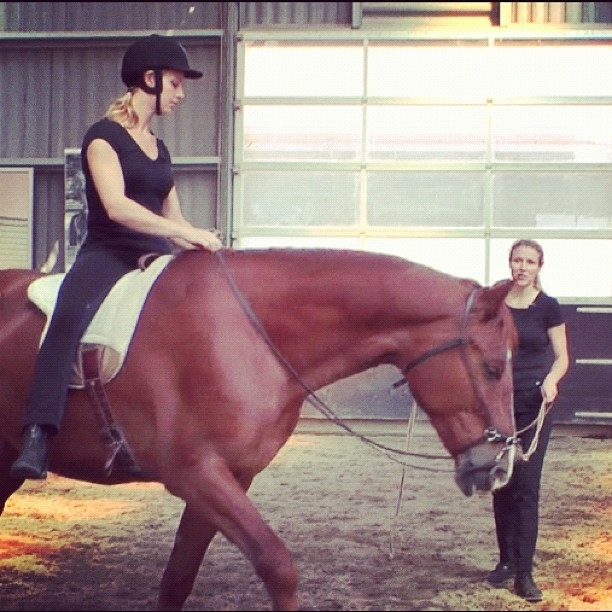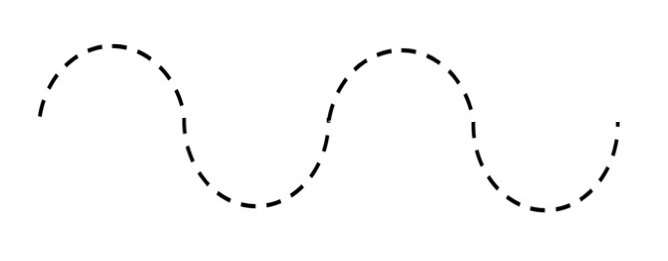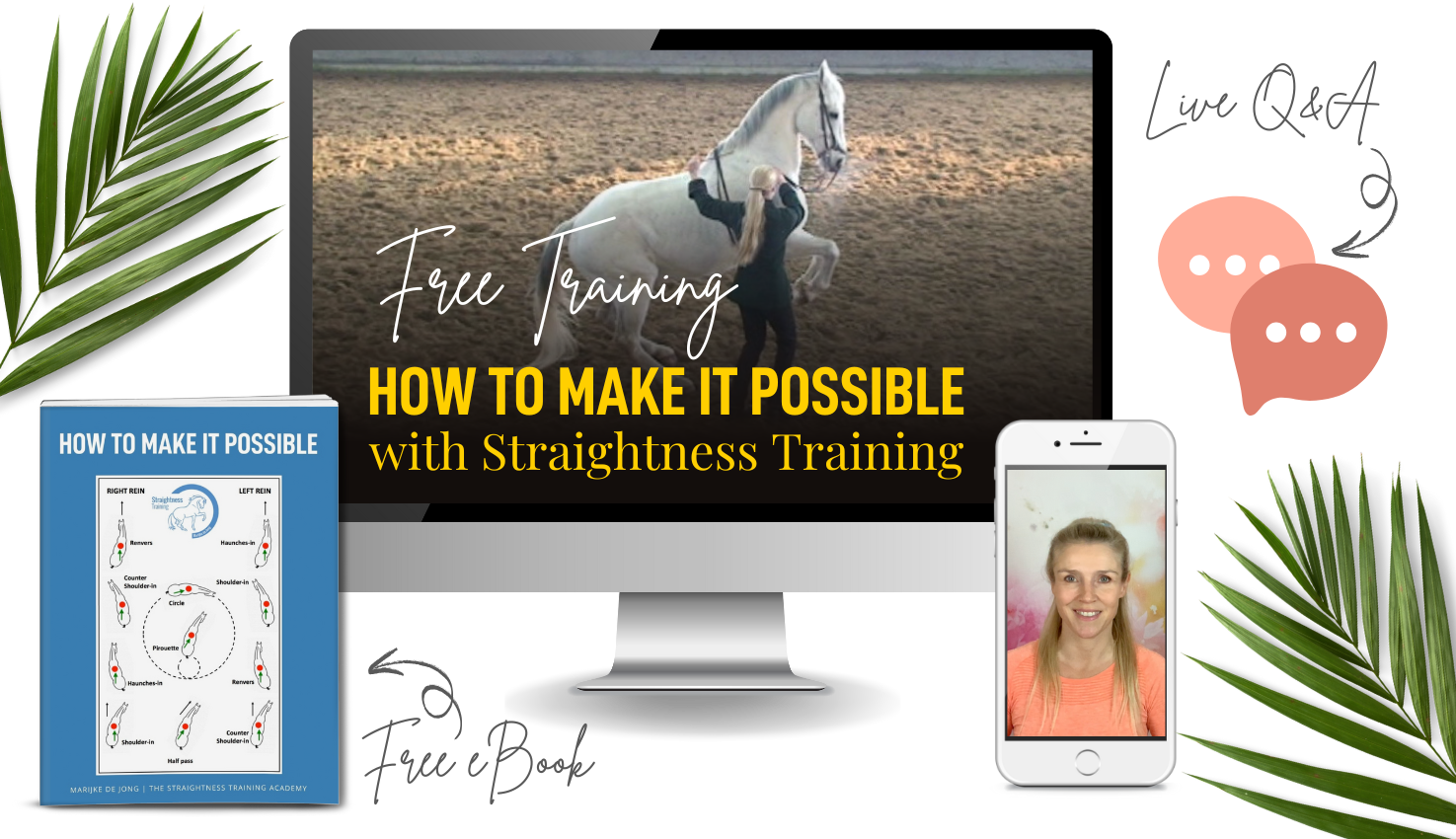
Riding
Riding is one of the five training pillars in Straightness Training.
When your horse horse is well prepared by groundwork, longeing and work in hand, you can start riding your horse.

Riding a horse is done using a cavesson, reins and a saddle or bareback pad.
As you become more advanced, you can use a combination of cavesson and bit and use two reins.
Herd of Aids
Naturally the horse is used to walk in a herd:
- The leading mare walks in front and decides the direction of the entire group.
- The stallion walks behind and decides on the tempo.
- Additionally, the horse reacts to the other horses that walk to his left and right.
To make it very simplistic: The horse stays behind the mare, in front of the stallion and between the other horses. In that position the horse can walk very confident and safe in the center of the group. The horse is used to respond to others, that is why a horse lets itself be ridden so well, and a solitary animal like a moose does not.
While riding the rider should take over the role of the surrounding horses: leading like the mare, deciding tempo like the stallion. The horses left and right in front of the horse are substituted by rein aids, through which the shoulders are guided. The horses to the left and right slightly behind the horse are substituted by the legs, guiding both hind legs of the horse. When training the horse for riding, the horse is taught to carry itself in a herd of seat, leg- and rein aids.

To take over the longeing aids
In the beginning rider and horse will be guided by a person on the ground. The person longeing the horse has taught the horse from the ground to make transitions and changes in tempo.
The rider will take over the aids gradually by giving seat, leg and rein aids.
A horse will learn the new aids as following:
Lets take the example on how to teach a horse to go forward:
- The rider will give the ‘new’ aid: slight pressure with the calves.
- The horse has learned to go forward when the longeur lifts his hand with whip. The longeing person will give this familiar ‘old’ aid safter the rider gave the ‘new’ aids.
When this is combined consistently, the horse will make the connection between the ‘new’ and the ‘old’ aid and will eventually respond immediately to the new aid as well.
Now if you don’t have a helper from the ground and you lack somebody’s assistance for starting the riding part, than it’s not impossible to start the riding. The consequences are that there is more risk to misunderstanding (confusion) and imbalance,, and it might take (much) more time for the horse to get to the same level of understanding and balance as you would reach with the assistance of a helper.
Exercises
Riding a horse independently from the helper on the ground, the following steps are taken:
1. On the longe line

Through legs, reins and seat the rider and the longeing person get the horse used to the aids to accelerate and slow down.
2. Making the circle bigger

By making the circle bigger, the horse learns to understand and combine the inside rein and inside leg of the rider.
3. Making the circle smaller

Then the horse learns to understand outside rein and outside leg by making the circle smaller.
4. Changing the lead

When the horse allows the outside aids to make the volte smaller, the horse can be asked to change the lead through the center.
5. Riding through the arena

By making the circle bigger and bigger, the rider can start to ride through the entire arena.
When the horse finds it difficult or hard to do for a long time, this can be alternated with circles.
6. Serpentines

The serpentines are very important to make the horse supple in the bendings and responsive to the aids of the rider.
7. Without longe line

In the end, the longeing person will no longer give any aids to support the horse.
Then the longe can be taken off. The rider should repeat all steps 1-6 with the longeing person first walking with the horse through the exercises.
The longeing person should then take more distance gradually.
8. Advanced riding
When the horse lets himself be led by the aids of the rider, more advanced riding training can begin.
The horse will go through a system of stages of progressive exercises to make him supple and strong, to be able to carry a rider properly:
- Circle
- Shoulder-in
- Haunches-in
- Renvers
- Half pass
- Pirouette
- Piaffe
- Levade
Through these stages the rider can develop the riding into a real art.

 .
.
The horse will learn most riding exercises as follows:
Step 1. In Straightness Training all exercises are first taught in hand. This teaches the horse how to perform these exercises and to find its balance without the additional weight of the rider.
Step 2. Later on, the horse will find it easier to learn and execute the same exercise under the rider with guidance from a helper on the ground.
Step 3. In the end the horse can do it with only the guidance from the rider.

What if you ride bitless? Is that a problem?
Not at all. The horse begins Straightness Training always bitless to spare the mouth if the horse is too stiff in its body because of natural asymmetry.
And if you would like to, a bit is only introduced later on in the horse’s education.
But of course this isn’t compulsory and if you wish to carry on bitless that is fine.
We’ve also developed Straightness Training at liberty, this is a very enlightening area of the training, because without any tack on the horse you really can improve your connection, harmony, togetherness and oneness with the horse.

How to mix ST with other types of riding?
Straightness Training is important in all riding disciplines, because all horses have their natural asymmetry. Therefore all horses need to be straightened in body and limbs.
So it doesn’t matter which discpline you ride, wether you do natural horsemanship, or jumping, wether you ride with bit, or without, with saddle, or without, wether you ride with two hands or with one: all horses need to carry their riders properly with the hind legs to support the back and enlighten the fragile front legs.

Professor Horses
Educated horses are great professors to teach riders the feeling of collection:

